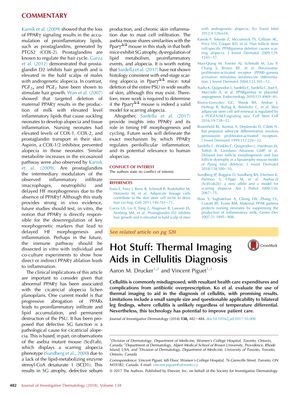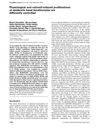Hot Stuff: Thermal Imaging Aids in Cellulitis Diagnosis
February 2018
in “
Journal of Investigative Dermatology
”
peroxisome proliferator-activated receptor gamma PPARγ hair follicle morphogenesis alopecia proinflammatory lipids hair cycle prostaglandin D2 androgenetic alopecia cicatricial alopecia lichen planopilaris asebia mouse model SCD1 scarring alopecia perifollicular inflammation imiquimod 5-FU MAL-PDT superficial basal cell carcinoma PPAR gamma hair follicle development hair loss inflammatory lipids hair growth cycle PGD2 male pattern baldness scarring hair loss LPP asebia mouse stearoyl-CoA desaturase-1 follicle inflammation Aldara 5-fluorouracil methyl aminolevulinate photodynamic therapy skin cancer

TLDR The document concludes that a protein involved in hair growth may link to baldness and that more research is needed on its role in hair loss and skin cancer treatments.
The document highlights the importance of peroxisome proliferator-activated receptor gamma (PPARγ) in hair follicle morphogenesis and its potential connection to alopecia. Studies cited include Karnik et al. (2009) who found that loss of PPARγ signaling leads to an accumulation of proinflammatory lipids affecting the hair cycle, and Garza et al. (2012) who discovered that prostaglandin D2 inhibits hair growth and is higher in men with androgenetic alopecia. Wan et al. (2007) showed that deletion of maternal PPARγ causes alopecia in neonates, preventable by aspirin. The document suggests prostaglandins may mediate inflammation and delayed hair follicle morphogenesis due to PPARγ absence, relevant to cicatricial alopecia lichen planopilaris. The asebia mouse model, lacking SCD1, shares features with the Ppary mouse model, including alopecia and proinflammatory events. Further research is needed to confirm the Ppary mouse as a scarring alopecia model and to understand how PPARγ regulates perifollicular inflammation in human alopecias. Additionally, a 5-year randomized trial by Jansen et al. (2017) found imiquimod more effective than 5-FU and MAL-PDT in preventing superficial basal cell carcinoma recurrence, underscoring the need for more research on treatment efficacy for skin cancer subtypes and patient populations.




